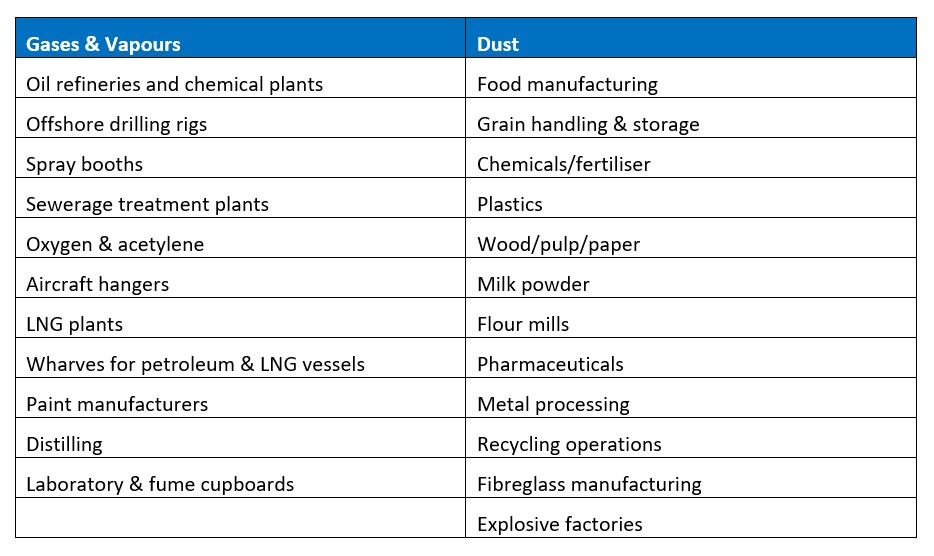Roar Solutions - An Overview
Roar Solutions - An Overview
Blog Article
Not known Details About Roar Solutions
Table of ContentsLittle Known Questions About Roar Solutions.What Does Roar Solutions Do?All About Roar Solutions
In order to secure installations from a possible explosion a method of evaluating and classifying a possibly harmful area is needed. The purpose of this is to make certain the right selection and setup of equipment to eventually prevent a surge and to ensure security of life.
(https://www.4shared.com/u/m0RNXdsL/thomascarrillo4740.html)
No devices needs to be mounted where the surface area temperature of the equipment is more than the ignition temperature of the given risk. Below are some usual dust harmful and their minimal ignition temperature level. Coal Dirt 380C 225C Polythene 420C (thaws) Methyl Cellulose 420C 320C Starch 460C 435C Flour 490C 340C Sugar 490C 460C Grain Dirt 510C 300C Phenolic Material 530C > 450C Aluminium 590C > 450C PVC 700C > 450C Soot 810C 570C The possibility of the danger being existing in a concentration high enough to cause an ignition will differ from area to place.
In order to identify this risk a setup is divided into locations of danger relying on the amount of time the dangerous is present. These locations are described as Areas. For gases and vapours and dusts and fibres there are three zones. Zone 0 Area 20 An unsafe atmosphere is extremely most likely to be existing and might exist for extended periods of time (> 1000 hours annually) or even continually Area 1 Zone 21 An unsafe ambience is possible yet unlikely to be present for extended periods of time (> 10 450 C [842 F] A classification of T6 suggests the minimal ignition temperature is > 85 C [185 F] Hazardous location electrical equipment maybe designed for usage in greater ambient temperature levels. This would suggested on the ranking plate e.g. EExe II C T3 Ta + 60C( This suggests at 60C ambient T3 will certainly not be surpassed) T1 T1, T2, T3, T4, T5, T6 T2 T2, T3, T4, T5, T6 T3 T3, T4, T5, T6 T4 T4, T5, T6 T5 T5, T6 T6 T6 A T Class score of T1 implies the optimum surface temperature level created by the tool at 40 C is 450 C. Presuming the associated T Course and Temperature ranking for the devices are ideal for the area, you can constantly utilize an instrument with a much more rigid Department score than needed for the area. There isn't a clear solution to this inquiry sadly. It truly does rely on the kind of tools and what repair work require to be executed. Tools with details examination treatments that can't be executed in the field in order to achieve/maintain third party ranking. Should return to the factory if it is before the tools's service. Field Fixing By Authorised Worker: Complex testing might not be called for nonetheless details treatments might require to be complied with in order for the devices to preserve its 3rd party score. Authorized personnel have to be utilized to do the job correctly Repair need to be a like for like replacement. New element should be considered as a direct substitute requiring no unique testing of the devices after the repair work is full. Each item of devices with a harmful ranking ought to be evaluated independently. These are laid out at a high degree listed below, however, for even more in-depth info, please refer directly to the guidelines.
The 2-Minute Rule for Roar Solutions
The devices register is an extensive data source of devices documents that includes a minimum collection of fields to recognize each product's area, technological parameters, Ex lover classification, age, and ecological information. This info is essential for monitoring and managing the devices effectively within harmful locations. In contrast, for routine or RBI sampling assessments, the quality will be a mix of Detailed and Close assessments. The proportion of Detailed to Close examinations will be figured out by the Tools Risk, which is examined based upon ignition risk (the likelihood of a resource of ignition versus the probability of a flammable ambience )and the unsafe area classification
( Zone 0, 1, or 2). This variant will certainly additionally influence the resourcing demands for job preparation. When Whole lots are defined, you can develop tasting strategies based upon the example dimension of each Whole lot, which refers to the number of random tools items to be evaluated. To figure out the needed example size, two elements require to be evaluated: the dimension of the Whole lot and the category of evaluation, which suggests the level of effort that ought to be applied( decreased, normal, or enhanced )to the inspection of the Lot. By combining the group of examination with the Whole lot dimension, you can after that establish the suitable rejection criteria for an example, suggesting the allowed variety of malfunctioning products found within that sample. For even more details on this process, please describe the Power Institute Guidelines. The IEC 60079 conventional suggests that the maximum interval in between assessments must not go beyond three years. EEHA inspections will also be carried out beyond RBI projects as component of scheduled upkeep and tools overhauls or repair services. These evaluations can be credited towards the RBI sample sizes within the influenced Great deals. EEHA inspections are performed to determine mistakes in electrical equipment. A heavy scoring system is crucial, as a solitary piece of tools may have numerous faults, each with differing levels of ignition threat. If the consolidated score of both examinations is less than two times the fault rating, the Great deal is deemed appropriate. If the Lot is still considered undesirable, it needs to undertake a full inspection or reason, which may activate more stringent assessment protocols. Accepted Whole lot: The reasons for any kind of faults are identified. If a common failure setting is found, added tools may need inspection and repair service. Mistakes are classified by intensity( Safety and security, Integrity, House cleaning ), making certain that urgent problems are examined and resolved promptly to reduce any type of influence on safety or operations. The EEHA database must track and videotape the lifecycle of mistakes along with the corrective actions taken. Executing a robust click for source Risk-Based Assessment( RBI )approach is essential for guaranteeing compliance and security in handling Electrical Devices in Hazardous Locations( EEHA) (hazardous area electrical course). Automated Mistake Rating and Lifecycle Administration: Easily handle faults and track their lifecycle to improve evaluation accuracy. The introduction of this assistance for risk-based inspection further strengthens Inspectivity's position as a best-in-class remedy for regulative conformity, as well as for any type of asset-centric assessment use case. If you are interested in learning extra, we welcome you to request a demonstration and uncover just how our remedy can transform your EEHA management processes.
The Best Guide To Roar Solutions

In regards to eruptive risk, a hazardous location is an atmosphere in which an eruptive environment exists (or might be expected to be present) in amounts that require unique safety measures for the construction, installment and use of tools. eeha training. In this article we discover the difficulties encountered in the work environment, the risk control actions, and the needed expertises to work securely
It is a consequence of modern-day life that we manufacture, keep or take care of a series of gases or fluids that are regarded flammable, and a variety of dirts that are deemed flammable. These materials can, in certain problems, create explosive environments and these can have significant and terrible repercussions. The majority of us know with the fire triangle get rid of any one of the 3 elements and the fire can not happen, yet what does this mean in the context of hazardous areas? When breaking this down right into its most basic terms it is basically: a combination of a specific quantity of launch or leakage of a certain substance or material, combining with ambient oxygen, and the existence of a source of ignition.
In the majority of instances, we can do little regarding the levels of oxygen in the air, however we can have substantial influence on resources of ignition, as an example electrical devices. Unsafe locations are recorded on the unsafe location category illustration and are recognized on-site by the triangular "EX-SPOUSE" indicator. Below, among various other essential info, areas are split into 3 kinds relying on the danger, the chance and period that an explosive environment will exist; Area 0 or 20 is regarded one of the most dangerous and Zone 2 or 22 is regarded the least.
Report this page